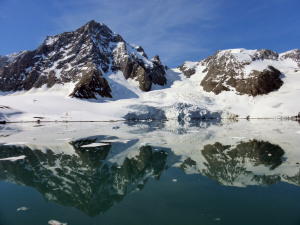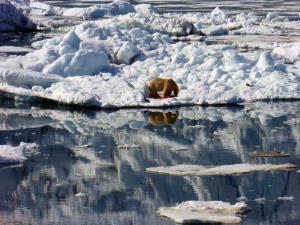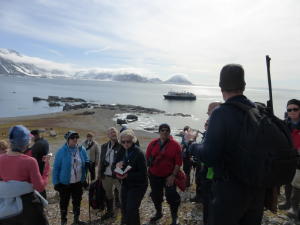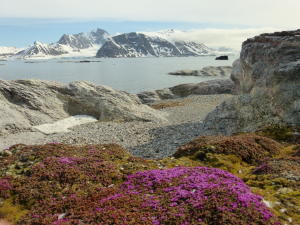|
June 11, 2013
 The
Svalbard Archipelago is a set of islands in the high Arctic. It
sits between 74 and 81 degrees north latitude and is 60% covered
with ice. The islands are governed by Norway. Spitsbergen is the
largest of the islands. We reached the southwestern tip of Spitsbergen
Island this morning under clear blue skies and crisp Arctic air.
The scenery was the most spectacular so far with jagged snow covered
mountains, glaciers and fast ice still clinging to the shore. This
type of ice is crucial habitat for seals this time of year to haul
out and rest. Where there are seals hauling out and fast ice, polar
bears patrol and hunt the seals. We sailed into the bight of Hornsund
in a side arm called Burgerbukta with everyone on the lookout for
a bear. It wasn't long before one of the naturalists on the bridge
spotted a suspicious cream-colored speck on the sea of white. After
closer inspection, he had indeed found an "ice bear".
In fact there was a female with two cubs in tow. The captain slowly
maneuvered us to the edge of the ice but could not get in too close
without disturbing them. We watched through binoculars and a telescope
set up on the bridge as another family of three bears came into
view, apparently on a kill. The first female started running toward
the kill, chasing the other family away and proceeded to feed. The
Svalbard Archipelago is a set of islands in the high Arctic. It
sits between 74 and 81 degrees north latitude and is 60% covered
with ice. The islands are governed by Norway. Spitsbergen is the
largest of the islands. We reached the southwestern tip of Spitsbergen
Island this morning under clear blue skies and crisp Arctic air.
The scenery was the most spectacular so far with jagged snow covered
mountains, glaciers and fast ice still clinging to the shore. This
type of ice is crucial habitat for seals this time of year to haul
out and rest. Where there are seals hauling out and fast ice, polar
bears patrol and hunt the seals. We sailed into the bight of Hornsund
in a side arm called Burgerbukta with everyone on the lookout for
a bear. It wasn't long before one of the naturalists on the bridge
spotted a suspicious cream-colored speck on the sea of white. After
closer inspection, he had indeed found an "ice bear".
In fact there was a female with two cubs in tow. The captain slowly
maneuvered us to the edge of the ice but could not get in too close
without disturbing them. We watched through binoculars and a telescope
set up on the bridge as another family of three bears came into
view, apparently on a kill. The first female started running toward
the kill, chasing the other family away and proceeded to feed.
 After
lunch, there was another sighting on the fast ice in Samarinvagen.
A lone male bear was feeding on a seal kill. This time we were able
to get close enough for great viewing and photos. We watched as
it tore chunks of blubber and flesh from the seal carcass, stopping
at times to clean its massive blood-stained paws. After
lunch, there was another sighting on the fast ice in Samarinvagen.
A lone male bear was feeding on a seal kill. This time we were able
to get close enough for great viewing and photos. We watched as
it tore chunks of blubber and flesh from the seal carcass, stopping
at times to clean its massive blood-stained paws.
 In
the afternoon, we made a landing at Gnalodden or "Nagging Point",
named for the raucous and busy seabird colony. Since this is polar
bear territory, all the naturalist guides carry flare guns and rifles.
There were always extra guides posted around the area keeping an
eye out for any surprise visits. We were told that from now on we
needed to always stay close to the guides on our hikes. The bears
can move very fast and if especially hungry could go after a tourist
who happenned to be in their territory. In
the afternoon, we made a landing at Gnalodden or "Nagging Point",
named for the raucous and busy seabird colony. Since this is polar
bear territory, all the naturalist guides carry flare guns and rifles.
There were always extra guides posted around the area keeping an
eye out for any surprise visits. We were told that from now on we
needed to always stay close to the guides on our hikes. The bears
can move very fast and if especially hungry could go after a tourist
who happenned to be in their territory.  We
climbed up the tundra for some great views of the surrounding area.
The purple saxifrage was blooming everywhere. Fortunately, we did
not encounter any polar bears! We
climbed up the tundra for some great views of the surrounding area.
The purple saxifrage was blooming everywhere. Fortunately, we did
not encounter any polar bears!
To view more photos from Spitsbergen Island, please go to Spitsbergen
Island Photo Gallery. To read about the next location visited,
go to Northern Spitsbergen.
Home
Locations Visited Photos Map
Contact Us
|
.jpg)